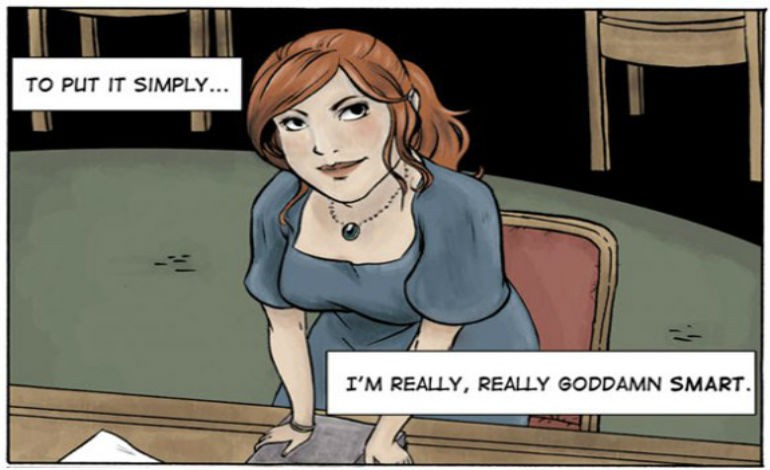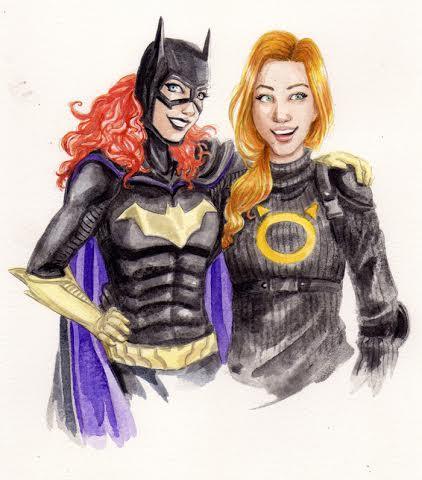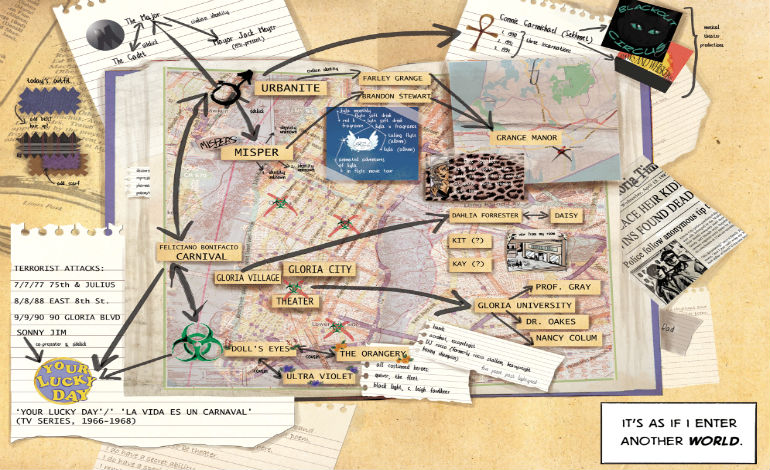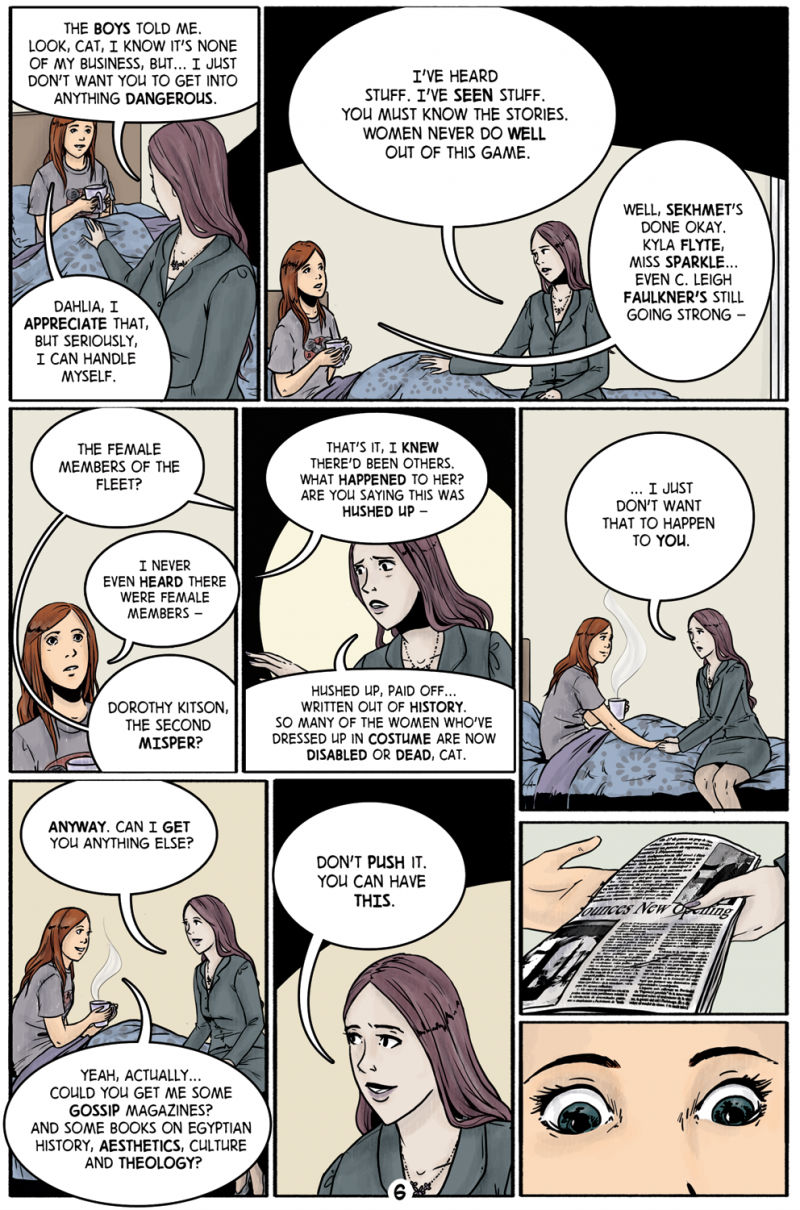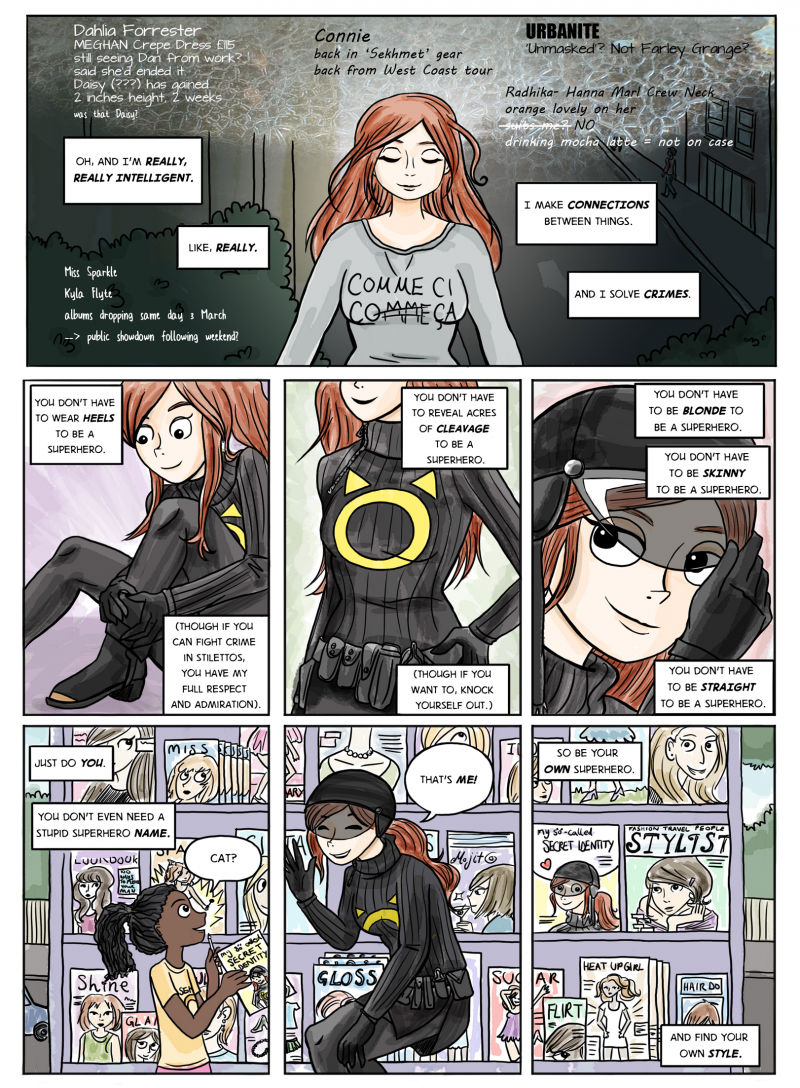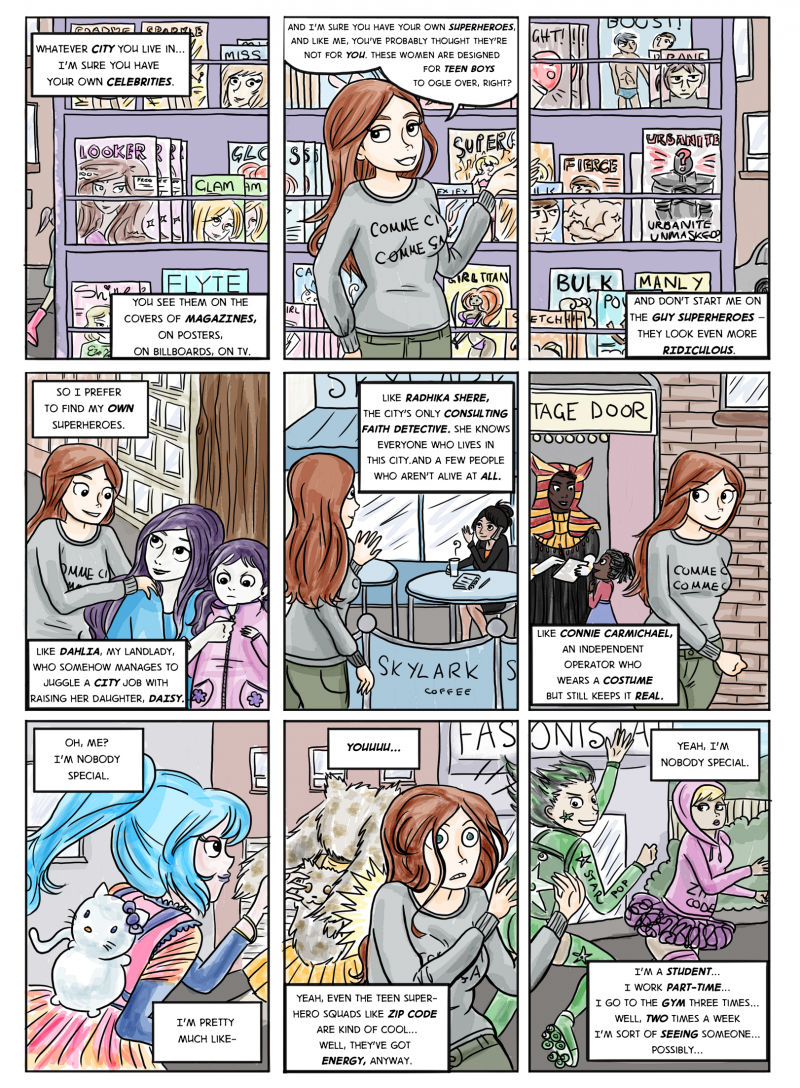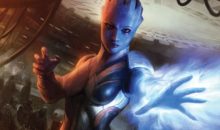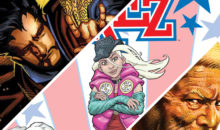My So-Called Secret Identity: An Interview With Will Brooker – Part 1
(Ed’s Note: This is part 1 of our interview with Will Brooker. To read part 2, click here.)
GEEKPR0N: In addition to being a Batman, Star Wars, and popular culture scholar, Dr. Will Brooker, along with his artistic collaborators Suze Shore and Dr. Sarah Zaidan, is the creator of the ongoing comics series My So-Called Secret Identity. I’ve had the opportunity to cover his work for GEEKPR0N, but after an offer to let me ask him some “difficult questions,” I found it too much an opportunity to resist. So here we are now: talking about the story of a woman, a city, and an entire comics world.
My So-Called Secret Identity features Cat, a young university student whose only power as you put it is that she is, “really, really goddamned smart.” She also exists in a really fascinating place known as Gloria City: where celebrity “superheroes, villains, and anti-heroes” seem to battle for prestige, money, and maintaining appearances. It’s, as you and Cat herself put it, become a “theater” for them: a play with a lot of collateral damage for its citizens. What and/or who was the inspiration behind the character of Cat? And how did you come up with the concept of Gloria City?
Will Brooker: I think there were various inspirations for Cat, which I’d have to think back and tease out now, as it’s two and a half years since the project’s inception.
The underlying premise, at one point, was ‘what if there had been a Vertigo title about Batgirl in the 1990s’, so in that respect, Cat is very much inspired by Barbara Gordon and the women of comics like Shade, Sandman and Doom Patrol.
In real life terms, I’d just started teaching a student called Babs, who — because it’s not a common name in my experience — made me start thinking what Babs Gordon might be like in real life, as an undergraduate; and I’d also just met a red-haired PhD student, Claire, which was no doubt also a factor. Again, one of the main ideas behind MSCSI was that Barbara Gordon had always been a PhD student, but her life never really seemed to resemble the lives of the students I knew.
So I wanted to try to bring the two ideas closer together, combining the concept of Batgirl with the largely female students I work with and am friends with.
Jennie Gyllblad recently painted us a lovely portrait of Batgirl with Cat, which demonstrates just how different they are and how they diverged: Barbara Gordon is really athletic and armored, and Cat is just averagely fit if that, wearing clothes she’s bought from regular stores. Although Batgirl was the original inspiration, Cat came to resemble much more a character from the Beano comic story ‘Billy the Cat and Katie’, who was the inspiration for Tammy (of ‘Tiger Tom and Tammy) in Grant Morrison’s series Zenith Phase III.
In terms of the name Gloria City, I was looking for something a bit like the city called Vanity in the short-lived comic book Aztek (Morrison again!) I liked the idea of Cat thinking of it as a friend or big sister, and the place having a woman’s name, like the city of Charlotte (and arguably, Sydney).
There is actually some Christian iconography in the Gloria University logo, and I like that the name captures a sense of joy, promise and becoming, even though clearly it’s a city with problems. As such, it is, like most comic book cities, somewhere between Metropolis and Gotham, which are themselves of course versions of New York City.
The map of Gloria is loosely based on NYC. The various districts are pretty much where you would find them in NYC — the bohemian Village, the theaters, the largely African American community, and so on. If you follow Cat’s routes in the comic, you can tell that she’s walking through areas which very much approximate Manhattan in their relation to each other.
In terms of the look, I think a lot of the detail, such as the hanging baskets and the streetlights, came from Suze. As she’s Canadian, it may well have a particular cultural angle to it. I think I suggested to Suze that it should be a bit like Vancouver in its atmosphere, with a music and cultural scene like Austin, TX. But as with a lot of things in MSCSI, it’s hard to be sure exactly who decided what.
GP: I definitely get the feeling that Cat thinks of herself as part of Gloria City as opposed to being above it, or her if you’d like to personify Gloria with a gender. I am really fascinated with your creation of Cat’s mind maps and how they fit into her sense of relation to Gloria. It’s kind of like an intersection of geography, her educational background, mnemonic devices (memory prompts and aids), and her own innate sense of exploration and a need for understanding. Is this partially what motivated you to create Cat’s mind maps? You mentioned in your interview with Julian Darius that Sarah Zaidan drew them, but was there anything in particular that inspired either of you to make these?
WB: Sarah created the MindMaps visually, from my directions in the script. All the details are there in the script, and a fair amount of information and suggestion about how the MindMap should look, and how the different elements should relate.
Again, a few different ideas prompted the MindMaps. I wanted to do something like Alias, where most of the story is told in a particular comic book narrative style, but there are sections where we dip out of the story into pastiche flashbacks, scrapbooks and magazine extracts, in an entirely different visual mode. (In a way,Watchmen did this with its endpapers, back in 1986).
MSCSI was always informed by the idea of scrapbooks. Ironically, it’s Jim Gordon, not Babs, who is working on a scrapbook when Joker arrives in The Killing Joke, but I felt that scrapbooking was more of a conventionally-female art form — Pinterest is the digital version — and part of the aim behind MSCSI was to foreground and celebrate alternative (again, conventionally-female) forms of art, craft and labour.
The scrapbook aesthetic works with our idea of collaboration and community, involving different, diverse versions of the cast members and a collective approach to their appearance and costumes. It embraces various art styles and encourages an approach to art as a process and work in progress, rather than just a finished page. It fits with our sense of workshopping.
Cat’s MindMaps are very much like an essay plan, I think, although they include everything in her life rather than just her academic work. They are meant to show how she makes sense of things and connects things. I imagine it’s a specifically arts and humanities way of reading the world: one reviewer compared it to Michel de Certeau’s notion of walking in the city. Her understanding of herself and her environment is visual and tactile, as well as just linguistic: it involves fabric, colours, scraps of paper, scrawled links.
One of the key ideas here was that while Batgirl is very, very clever, I didn’t think we often saw that in stories about her. How do you show thought processes, in comics? You can have someone piece a mystery together, but that requires a certain kind of detective plot, and Cat wasn’t going to be in that situation from the start: she’s just living a fairly normal life. So the MindMaps give us access to the way she thinks, even before she starts trying to investigate the enigmas surrounding Urbanite and Misper.
GP: That is very fascinating. I mean, in most detective comics — whether they are based on the Dark Knight or earlier and alternative stories — you have the characters telling other characters or, really, the reader the analytic and synthetic process by which they came to their deduction. It makes sense in that police forces are depicting as utilizing maps, newspaper clippings and notes on bulletin boards in order to link clues together and come to some kind of conclusion about a crime. And as for the comics medium itself, you can attempt to show processes through a thought-bubble or even some captioned flashbacks. But these maps really are the closest thing in comics to how a human mind really works: as we all think in a mixture of sounds, images, words and other senses.
The maps remind me of the concept of psycho-geography: of places being linked with past events and emotions. Speaking of Alan Moore’s work, he has drawn on this concept through Sir William Gull’s twisted personal paradigm in From Hell, while I also know that Grant Morrison and Daniel Vallely used the model in a flat-out collage aesthetic in Bible John: A Forensic Meditation. When I say that now, I realize that these comics also deal with crime, but from very masculine perspectives — from a killer and potential investigators — and with regards to violence and murder against women. But you use the MindMap and the multimedia (I am thinking of Watchmen) of the scrapbook differently with regards to Cat and even her relation to the time and place of Gloria City.
WB: It’s true that the MSCSI MindMaps are actually strikingly similar to the bulletin boards of images and links we see in crime drama — The Wire, for instance, or more recently True Detective andFargo — where a main character is trying to connect the dots of a murder or a conspiracy. I didn’t explicitly think of that, but it’s probably the most obvious visual echo. I’d have to check the script to see exactly what I specified and what Sarah added to the concept.
The MindMaps do recall Bible John and From Hell in a way. I didn’t have them explicitly in mind, but I’ve read and enjoyed them both. I was asked last year to write MSCSI as a script treatment for a movie, by an agency that ultimately didn’t take the project on, and in adapting the MindMaps for a new medium, I came up with an idea that’s again quite similar to the pentagram across the city in From Hell, and also the Riddler’s use of the city in Batman: Zero Year.
In fact, a lot of Zero Year reminds me strongly of MSCSI now — the dispersed power of the Red Hood gang, the grim joke about demolishing buildings as ‘dominoes’ — which I think demonstrates how these ideas just float around in the creative consciousness, recurring in different forms and different texts. It’s obviously a complete coincidence that aspects of Zero Year recall MSCSI, but it probably says something about the links between MSCSI and From Hell too — that echoes aren’t always deliberate.
It would be interesting to consider whether the MindMaps are any different from the other texts because of their female perspective. On a really superficial level, I doubt Batman would have swatches of material in his head, as he plans his outfit while also trying to remember where terrorist attacks took place. But someone like Tony Stark, who seems to take more genuine pleasure in his wardrobe and social life, might do.
The videos produced by Rebecca for our Kickstarter and Sound & Vision page probably come closest to showing what the MindMaps would ‘really’ look like, as they’re animated and include sound and music.
Video Credit: “Bright Yellow Gun,” Beccatoria
GP: I had no idea that you were asked to write a film treatment for MSCSI, but that said I can see through the videos that Rebecca created some of the MindMap material unfolding and animated. I do hope that, eventually, MSCSI and Cat get their chance to go from “the theater” to the theatre screen.
I’d like to focus a little bit on the theatre metaphor for MSCSI. There was a black and white scene in Issue #4 depicting a children’s show. This happened thirty years before the events of MSCSI. When a reader really looks at those MindMaps, they can get a hint of not only what will happen, but how things possibly relate to each other. And Carnival is mentioned in reference to this show. Did the theatre truly originate from that show? Do all the heroes, villains, and anti-heroes relate to Gloria City only through the metaphor of the theatre (aside from Carnival who, at best, thinks of it all as some kind of interactive game)?
WB: The theatre, as in the whole superhero culture of MSCSI, began in either 1945 or 1954. Nobody in Gloria City can easily remember exactly when it was — they just have those key historical dates in their head, from school or magazines, or it’s just something ‘everyone knows’, but when they try to pin it down they’re not quite sure where they heard it.
Anyway, there were some significant events that again, ‘everyone knows’ in the same way that we know JFK died and people landed on the moon, and after that, there were costumed figures who seemed to do things better, stronger, faster than normal folk, and it all progressed from there.
This is all my exploration of comic book continuity, and the fact that characters in comics have to deal with history being rewritten, rebooted and revised at regular intervals. We’ve already seen instances of this, where Dahlia can remember details about the Fleet and the female Misper that Cat’s forgotten. (Because Dahlia’s a little older and has a different sense of history). There’s further suggestion of the past in the newspaper page that recurs through Issue 3. I want to spell this out a lot more explicitly in Volume 2.
Carnival and Cat are, I’d say, the only ones who really recognise and admit that this whole superhero dynamic is a kind of theater or game. Carnival embraces and plays with the idea. Cat has really only just realised it, and to her that makes everything even more unethical and sickening — that other people are being damaged in a power-play between half a dozen larger-than-life figures.
Kyla, Connie and Miss Sparkle would accept that it’s all business, a staged conflict to sell product. Urbanite would stubbornly resist that idea. He needs to believe it’s a never-ending war on crime, and that it’s all entirely legitimate — that he is genuinely locked into battle with people like Carnival. Even if he might believe the truth deep down, he’d be reluctant to admit it even to himself, and would never say so out loud.
The ‘It’s Your Lucky Day’ show was Carnival’s TV series, back in more innocent times, when he was a cartoonish, avuncular persona. If we saw Urbanite guest star on that TV show, he’d be a figure like Adam West’s Batman (this would, of course, be another person in the Urbanite costume, as it all took place a generation ago). It would be pretty good to revisit that idea, in fact, and see what Urbanite was like in the 1960s.
GP: An Adam West-like Urbanite would be entertaining, to put it mildly. The theatre of Gloria City and its characters can say other things about our world behind the comics culture as well. Cat herself represents something new or at least seen less often in superhero comics. After seeing Cat working with her friends Kit and Kay on her costume and reading the Extras section of MSCSI’s website, it just reminds me of the fact that many comics fans become involved in the industry in some way themselves: either becoming a part of the structure or making their own fandoms. Not only can you become a creator, you can also be like or be your own hero. Could you interpret Cat as an in-universe representation of that idea? As that counterpoint to the corporate capes and crusaders: that line between a Do-It-Yourself movement of cosplaying fans and more independent and relatable heroes?
WB: I didn’t really have that interpretation at the front of my mind, but it definitely fits. It could be seen as exploring the kind of career path from fan to creator; a path many people have taken, within comics, novels and TV. Of course, a creator can still be (and should be) a fan, and still be critical. And in a way, Cat is engaging in a form of fan practice, or perhaps anti-fan practice: her logo is adapted directly from a commercially-bought Urbanite stencil kit. So she’s subverting official materials and making her own brand, and costume, from available materials. It’s exactly what fan scholars call ‘transformative works.’
One of the questions raised there is whether, by moving further ‘inside’ the structures, you lose some edge, distance and critical perspective. That is certainly an angle that could be applied to Cat’s position in Volume 2, which begins some months later, when her role as a kind of ‘hero’ is more established. She’s gained a certain degree of celebrity and respect from other costumed figures, and is on the level where she can actually talk to Kyla Flyte.
So if you apply that interpretation, MSCSI offers a commentary on the compromise and negotiation between becoming more popular and successful, and ‘selling out’.
GP: That has definitely been a question on my mind as I’ve been following the series so far: as to how far Cat will play in the theatre and if she will change the system, or become a part of it. I can definitely see her bringing some kind of unique innovation to the theatre, and Gloria City: perhaps starting a trend in empowering its citizens — particularly its female citizens — through fandom and example and showing them that ordinary people can be heroes because, in MSCSI’s promotional words, “Smart is a superpower.”
In your interview with Nick Ford, you mentioned that your agreements with your collaborators and sponsorships for MSCSI are based off of something called “gift economy”: which you said was something prevalent in female fan communities and is a model with less emphasis on contracts and business deals and more about hand-shake agreements, networking, and exposure. Are there any examples of female fan community “gift economy” that influenced your MSCSI collaboration and, tying it back to fandom and culture, could this concept play some part in Cat’s own potential influence on Gloria City society?
WB: The question of how Cat will function within and change the nature of Gloria’s costumed community will be a key issue in Volume 2. She becomes a more prominent media figure and a role model to an extent, and feels she has new responsibilities.
However, the whole community will change during Volume 2 anyway, as one of the underlying plot points is that all the big hitters, who are male, have been lured away on another ‘mission’, so the people left in the city who qualify as ‘superheroes’ are second-stringers and predominantly female, of various generations from 18 to retirement age.
So because of that change, Cat finds she has an even more decisive role, as the newest and most prominent young female ‘costume’ on the scene.
I’ve just written a short chapter for a new book about crowdfunding, which says a little more about my debt to the notion of gift economies. Here’s an extract.
My approach was informed by what I knew about fan communities; specifically female fan communities, and even more specifically, the communities discussed by Karen Hellekson and Kristina Busse in their book Fan Communities in the Age of the Internet. They explained the process of ‘gift economy’, where one fan does something for another – writes a story, creates an avatar – in a system of informal, friendly trade, without any fixed arrangement or desire for financial reward. The items exchanged, gestures of time and skill, ‘have no value outside their fannish context […] Gifting is the goal. Money is presented less as a payment than as a token of enjoyment.’
Every week brings new examples of that in practice. I have a friendly agreement with the ethical underwear company Who Made Your Pants? that we will cross-promote and support each other, during this period at least. I’ve literally been sending gifts to a few MSCSI fans across the world, not for any kind of expected return — but nevertheless, it feels indirectly like a kind of thanks for their positive reviews and their continued support. There have been very, very few contracts between me and the artists, even those I’ve never met and have only dealt with once. I don’t have any form of written agreement with Sequart or Geeked; it is just about a mutually respectful admiration and a shared set of ideas.
Again, I think we could see some of this in Volume 2 of MSCSI, where I envisage Cat as — initially at least — being a little like Man-Of-Bats, the Native American Batman of Grant Morrison’s comic, who works on a very local level. The introduction of Radhika Shere, our analogue of John Constantine, and her relationship with Cat, will play into this idea — people doing each other favours within the community and knowing it’ll be repaid somehow.
As in Volume 1, though, we start off on a nice, easy-going local level, with people just hanging out and enjoying every day dynamics, but comic book drama kicks in and Cat is caught up in another larger-scale dilemma before long.
GP: I see. “Gift economy” kind of reminds me of the concept of bartering: of trading items and goods instead money. There is definitely a major element of networking and promotion involved in this model with regards to your fans and supporters — and I can see those favours coming in real handy between Cat and other heroes that were left behind in Gloria City. I’m definitely interested in seeing how you subvert the “lower-tier hero” and “all-star superheroines” trope story arcs for the next volume.

